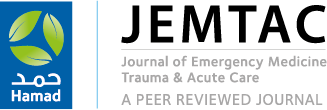-
oa Evaluation of the development and frequency of acute kidney injury in geriatric patients after intravenous contrast media use in the emergency department
- Source: Journal of Emergency Medicine, Trauma and Acute Care, Volume 2025, Issue 2, Apr 2025, 14
-
- 08 August 2024
- 27 January 2025
- 08 April 2025
Abstract
Background: Considering the aging society, there are few studies on the development of contrast-induced nephropathy (CIN) in emergency departments (EDs), especially in geriatric age groups. The aim of this study was to evaluate the effects of intravenous contrast media use for computed tomography on the development of acute kidney injury (AKI) in geriatric patients admitted to the ED.
Methods: This was a single-center, retrospective study. Patients aged ≥65 years presenting to the ED with an indication for contrast-enhanced computed tomography with serum Creatin and urea values within 8 h before imaging and 24–48 h after imaging were included in the study. The contrast agent used was IOHEKSOL (100 ml/300 mg). Patients with elevated serum creatine values 24–48 h after contrast-enhanced computed tomography were considered as contrast-induced acute kidney injury (CI-AKI).
Results: This study included 420 patients. The number of patients who developed CI-AKI was n = 35. When the characteristics of the patients were compared according to the development of CI-AKI, significant differences were found in terms of baseline creatinine value, eGFR and all severity indicators of CI-AKI (hypotension, hypoalbuminemia, and intensive care unit admission) (p < 0.05 for all).
Conclusion: Our study showed that the development of CIN in geriatric patients presenting to the ED was the same as in the general population and that the basal urea, sCr, and eGFR values of the patients also influenced the development of CIN. We believe that this study may be useful to know the comorbidities and laboratory values of patients before contrast extraction in order to be prepared for a possible complication.



